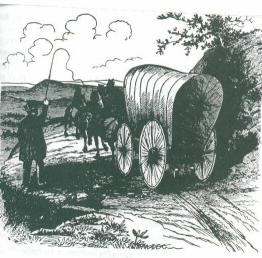Three Rivers
Hudson~Mohawk~Schoharie
History From America's Most Famous Valleys
The
Frontiersmen of New York
by
Jeptha R. Simms
Albany, NY 1883
 Volume
I, Page 356.
Volume
I, Page 356.
Mammoth Wagons.-- While the Mohawk was literally filled with boats of different kinds, for nearly every family living upon its banks had some kind of one, and Schenectada was a live town for receiving and dispatching freight on and off them; large wagons, to which allusion has been made, were used in competition with them in the transportation of merchandise and produce to and from Western New York. The produce, wheat, whiskey and potash, came to Albany, from whence merchandise was returned. Those wagons, covered with canvas, and drawn by three to eight horses, were seen in numbers on the Western and Mohawk turnpikes. The leaders usually had a little bell fastened upon the headstall. Mr. Alonzo Crosby, long superintendent on the eastern part of the Western turnpike, counted up 50 or more taverns or inns between Albany and Cherry Valley, in the distance of 52 miles. Palatine Church, a hamlet at that period of some importance on the Mohawk turnpike, was 51 miles from Albany, the inns in that distance also averaging one in every mile. Indeed, innkeepers were neighbors on those roads for a hundred miles to the westward of Albany. At this period tavern keeping was a lucrative business, especially for the house: prepared with enclosed sheds and good stabling.
Not a few novel incidents transpired on those roads, embracing accidents, etc., could they be garnered up. Not only friendships, but sometimes jealousies, existed among those teamsters. Here is an account of a quarrel between two teamsters on the Mohawk turnpike, involving a sort of melodrama. Samuel Brown, of Herkimer county, owned several of those four to eight horse teams, one of which he drove himself. One team consisted of four large gray horses. He met, in making a trip, a Massachusetts teamster with a large wagon, with whom he had had some difficulty; and being a large and strong, man and his adversary a small man, Brown thought to chastise him, which he not only threatened, but actually give him several cuts with a heavy whip, such as that craft used. Said Brown, curtly, "I will dispense with the whip, only on condition that you dance." Taken at a disadvantage with no one by, the Yankee teamster made a virtue of necessity, and did dance, to the great satisfaction of Brown, his only music being the crack of the long black whip.
Another phase in the picture, which had two sides. The Yankee, having satisfied his adversary's vain glory, walked deliberately to his own wagon, took from it an old musket, and, with it ready cocked, he confronted Brown with the gun's muzzle at his breast: "Now, d--n you! do you dance, or you'll receive the contents of this gun!" Resolution and determination were so depicted in the eye of his antagonist, that Brown, satisfied for once that he had caught a Tartar, with a forlorn look instantly struck off on a waltz, to the delight of "Massachusetts," who was ever after allowed a wide berth on the road. Long after this event transpired, and only a few years before the death of Brown, my informant, Maj. David Crouse, at a court in Johnstown, met him in a bar room and heard him relate this anecdote. Brown said this Yankee was the only man who ever made him dance, and he had done it by exercising martial law. Maj. Crouse died March 23, 1880, at the age of 72 years.
The horses before those wagons, which at times had a hundred or more bushels of wheat on, never traveled out of a walk. At the period of their use, brakes were unknown in descending hills, but a heavy iron shoe was used, on the six inch tire, which could be thrown from the wheel at the foot of the hill, by a spring managed by the foot of the driver. The teamsters usually went on foot, whip in hand, and their constant travel worn a good foot path along each side of the road, near the fence, a hundred miles from Albany. The horses were seldom stabled nights, but had an oilcloth covering, and were fed from a box or trough, carried along and attached to the pole, which could not fall to the ground. The rear of the wagon was ornamented with a tar bucket and a water pail. The wagons were painted blue, or slate color, and the covering remained white. A small box was secured upon one side or end of the wagon, containing a hammer, wrench, currycomb, etc. Those wagons paid no toll, as they filled the ruts made by farm wagons. Some of the teams were driven by a single line on the forward nigh horse; but those large Pennsylvania horses were so well trained as to be dexterously managed with a long leather whip. When it was heavy traveling, those monster wagons progressed but a few miles in a day; sometimes being two weeks in going from Albany to Geneva, Canandaigua or Rochester. Freight on merchandise west was, at first, one dollar a hundred from Albany to Utica. Although there were so many taverns on the road, still, so numerous were the teams that, at times, one of a party in company was mounted and sent forward before night to secure accommodations with a good wagon yard enclosure.
Copyright © 1998, -- 2003. Berry Enterprises. All rights reserved. All items on the site are copyrighted. While we welcome you to use the information provided on this web site by copying it, or downloading it; this information is copyrighted and not to be reproduced for distribution, sale, or profit.